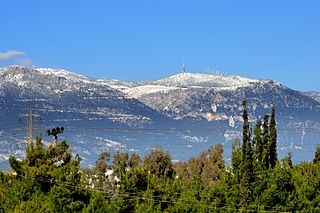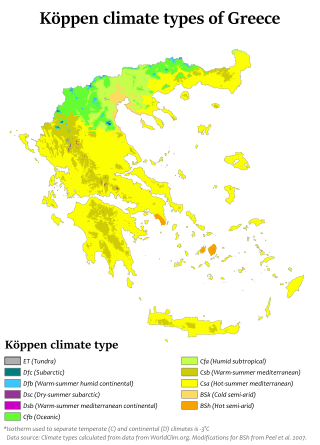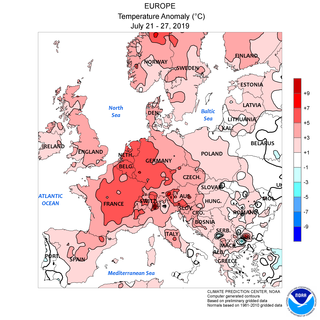
A heat wave or heatwave, sometimes described as extreme heat, is a period of abnormally hot weather. Definitions vary but are similar. A heat wave is usually measured relative to the usual climate in the area and to normal temperatures for the season. Temperatures that humans from a hotter climate consider normal, can be regarded as a heat wave in a cooler area. This would be the case if the warm temperatures are outside the normal climate pattern for that area. High humidity often occurs during heat waves as well. This is especially the case in oceanic climate countries. Heat waves have become more frequent, and more intense over land, across almost every area on Earth since the 1950s, the increase in frequency and duration being caused by climate change.

The 2003 European heat wave saw the hottest summer recorded in Europe since at least 1540. France was hit especially hard. The heat wave led to health crises in several countries and combined with drought to create a crop shortfall in parts of Southern Europe. The death toll has been estimated at more than 70,000.

Mount Parnitha is a densely forested mountain range north of Athens, the highest on the peninsula of Attica, with an elevation of 1,413 m, and a summit known as Karavola (Καραβόλα). Much of the mountain is designated a national park, and is a protected habitat for wildfowl, first created in 1961. The summit is located 18 km north of Acharnes and about 30 km north of the Athens city center. The mountain covers approximately 250 km² of land. Other peaks include Mavrovouni (Μαυροβούνι), Ornio, Area, Avgo or Avgho, and Xerovouni. It also has two shelters Mpafi and Flampouri. The name of the mountain dates back to ancient times, when it was under the ancient demes of Acharnae and Decelea.

The climate in Greece is predominantly Mediterranean. However, due to the country's geography, Greece has a wide range of micro-climates and local variations. The Greek mainland is extremely mountainous, making Greece one of the most mountainous countries in Europe. To the west of the Pindus mountain range, the climate is generally wetter and has some maritime features. The east of the Pindus mountain range is generally drier and windier in summer. The highest peak is Mount Olympus, 2,918 metres (9,573 ft). The northern areas of Greece have a transitional climate between the continental, the Mediterranean and the humid subtropical climate. There are mountainous areas that have an alpine climate. Also, various areas of Greece have semi-arid climates.

The 2010 Northern Hemisphere summer heat waves included severe heat waves that impacted most of the United States, Kazakhstan, Mongolia, China, Hong Kong, North Africa and the European continent as a whole, along with parts of Canada, Russia, Indochina, South Korea and Japan during July 29, 2010. The first phase of the global heatwaves was caused by a moderate El Niño event, which lasted from June 2009 to May 2010. This lasted only from April 2010 to June 2010 and caused only moderate above-average temperatures in the affected regions, but it also set new record high temperatures for most of the area affected in the Northern Hemisphere.
The 2013 heatwave in the United Kingdom and Ireland was a period of unusually hot weather primarily in July 2013, with isolated warm days in June and August. A prolonged high pressure system over Great Britain and Ireland caused higher than average temperatures for 19 consecutive days in July, reaching 33.5 °C (92.3 °F) at Heathrow and Northolt.

The 2018 Britain and Ireland heatwave was a period of unusually hot weather that took place in June, July and August. It caused widespread drought, hosepipe bans, crop failures, and a number of wildfires. These wildfires worst affected northern moorland areas around the Greater Manchester region, the largest was at Saddleworth Moor and another was at Winter Hill, together these burned over 14 square miles (36 km2) of land over a period of nearly a month.

The 2018 European drought and heat wave was a period of unusually hot weather that led to record-breaking temperatures and wildfires in many parts of Europe during the spring and summer of 2018. It is part of a larger heat wave affecting the northern hemisphere, caused in part by the jet stream being weaker than usual, allowing hot high-pressure air to linger in the same place. According to the European Drought Observatory, most of the areas affected by drought are across northern and central Europe. According to the World Meteorological Organization, the severe heat waves across the northern hemisphere in the summer of 2018, are linked to climate change in Europe, as well as events of extreme precipitation.
In 2018, several heat waves with temperatures far above the long-time average and droughts were recorded in the Northern Hemisphere: The earth's average surface temperature in 2018 was the fourth highest in the 140 years of record keeping. It is assumed that the jet stream is slowing down, trapping cloudless, windless and extremely hot regions of high pressure. The jet stream anomalies could be caused by polar amplification, one of the observed effects of global warming.
A tropical night is a term used in many European countries to describe days when the temperature does not fall below 20 °C (68.0 °F) during the nighttime. This definition is in use in countries including the United Kingdom, Greece, Republic of Ireland, Spain, Portugal, Denmark, Sweden, Norway, the Netherlands, Germany, Finland, Lithuania, Latvia, Hungary, Romania, Italy, Serbia, and Croatia. In the United States, by contrast, the term sultry nights is used when the temperature does not fall below 27 °C (80.6 °F) in the Gulf and Atlantic states.

In late June and late July 2019 there were two temporally distinct European heat waves, which set all-time high temperature records in Belgium, France, Germany, Luxembourg, the Netherlands, and the United Kingdom.

The 2021 Western North America heat wave was an extreme heat wave that affected much of Western North America from late June through mid-July 2021. The heat wave affected Northern California, Idaho, Western Nevada, Oregon, and Washington in the United States, as well as British Columbia, and in its latter phase, Alberta, Manitoba, the Northwest Territories, Saskatchewan, and Yukon, all in Canada. It also affected inland regions of Central and Southern California, Nevada, and Montana, though the temperature anomalies were not as extreme as in the regions farther north.

In 2022, several areas of the world experienced heat waves. Heat waves were especially notable in East Asia, the Indian subcontinent, Australia, western Europe, the United States, and southern South America. 2022 heat waves accounted for record-breaking temperatures and, in some regions, heat-related deaths. Heat waves were worsened by the effects of climate change, and they exacerbated droughts and wildfires.

The 2022 United Kingdom heatwaves were part of several heatwaves across Europe and North Africa. The United Kingdom experienced three heatwaves; the first was for three days in June, the second for three days in July, and the third for six days in August. These were periods of unusually hot weather caused by rising high pressure up from the European continent. There were also more grass fires and wildfires than average, and in August a drought was declared in many regions.

From June to August 2022, persistent heatwaves affected parts of Europe, causing evacuations and killing tens of thousands. These heat waves were the deadliest meteorological events in 2022. The highest temperature recorded was 47.0 °C (116.6 °F) in Pinhão, Portugal, on 14 July.

A number of heat waves began across parts of the northern hemisphere in April 2023, many of which are ongoing. Various heat records have been broken, with July being the hottest month ever recorded.

In 2023, Europe had been affected by heat waves. The most significant of which was the named heat wave, Cerberus Heatwave, which brought the hottest temperatures ever recorded in Europe. Starting on 10 July 2023, the record-breaking Cerberus anticyclone affected many European countries, with the effects felt most severely in parts of Southeast and Southwest Europe such as Cyprus, Greece, Italy, and Spain. The private Italian weather website iLMeteo named the extreme weather event after the hound of Hades from Greek mythology, and although some reports link the naming to the Italian Meteorological Society, the society's president said that they "absolutely don’t use it".

In July 2023, multiple wildfires started in Greece. They resulted in at least 28 deaths and injured 75 people, with over 80 wildfires being recorded. Seventy-nine people were arrested for arson.
Europe has been affected by heat waves since June 2024, breaking several regional temperature records across multiple nations in Southern and Southeast Europe.

















